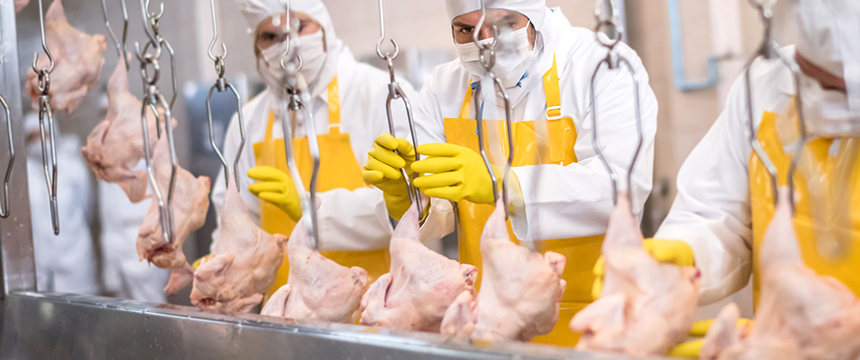
On Sunday, April 26th, the Centers for Disease Control and Prevention (CDC) and the Department of Labor (DOL) issued interim guidance specific to the meat and poultry processing industry to facilitate ongoing operations and support the food supply, while also mitigating the risk of spreading COVID-19.
The new guidance covers a number of critical issues ranging from screening and monitoring workers to cloth coverings and personal protective equipment and addressing return to work. In addition to following the enumerated recommendations, regulated entities are encouraged to follow evolving state and local rules. A summary of key takeaways from the new CDC/DOL guidance follows below.
Cleaning and Disinfection in Meat and Poultry Processing Plants
Regulated establishments should establish protocols and provide supplies to increase the frequency of sanitization in both work and common spaces, including frequently touched surfaces like tools, microwaves, and door handles. Workers who are tasked with cleaning and disinfecting these areas may require additional personal protective equipment (PPE) and other controls to protect them from chemical hazards posed by disinfectants.
Screening and Monitoring Workers
When implementing screening procedures, employers should coordinate with state and local health officials and occupational medicine professions.
Various screening policies and procedures may be implemented including:
- Screening workers prior to entry into the facility;
- Providing verbal1 screening in appropriate language(s) to determine whether workers have had a fever, felt feverish, or had chills, coughing, or difficulty breathing in the past 24 hours; or
- Checking temperatures of workers to identify anyone with a fever of 100.4℉ or greater (or reported feelings of feverishness).
Employers should ensure that:
- Screeners are trained to use temperature monitors;
- Temperature monitors are accurate under conditions of use;
- Screeners wear appropriate PPE such as gloves, a gown, a face shield, and, at a minimum, a face mask.
- There are engineering controls to maintain at least six feet of distance between screeners and workers being screened.
Managing Sick Workers
Workers who appear to have symptoms upon arrival to work or become sick during the workday should immediately be separated from others and sent home. Employers should ensure that personnel managing sick employees are appropriately protected from exposure including social distancing and wearing appropriate PPE.
If a worker is confirmed to have COVID-19, the employer should:
- Inform anyone that individual had come into contact with in the workplace, while maintaining confidentiality as required by the Americans with Disabilities Act (ADA), and instruct them how to proceed based on the CDC Public Health Recommendations for Community-Related Exposure</a>;
- Disinfect the workstation and any tools handled by the symptomatic worker; and
- Work with the state, local, tribal, and territorial health officials to facilitate the identification of other exposed and potentially exposed individuals.
Addressing Return to Work
Employers should consult with an occupational health provider and state and local health officials to develop the most appropriate reintegration plan.
- For reintegration of exposed, asymptomatic workers, employers should follow the CDC Critical Infrastructure Guidance. The guidance advises that employers may permit workers who have been exposed to COVID-19, but remain without symptoms, to continue to work, provided they adhere to additional safety precautions.
- For reintegration of workers with COVID-19, the worker should not return to work until they have met the criteria to discontinue home isolation, and have consulted with their healthcare providers and state and local health departments. The employer should follow the CDC interim guidance, “Discontinuation of Isolation for Persons with COVID-19 Not in Healthcare Settings.”
To manage the continuation of work, employers should determine which positions are critical to workflow by analyzing work tasks, workplace specific workforce availability, and hazard assessment associated with the tasks and workplace. Employers should consider cross-training workers to perform critical duties to minimize the total number of workers needed to continue operations.
Cloth Face Coverings
The CDC recommends that meat and poultry establishment employees wear cloth face coverings as a protective measure in addition to social distancing (i.e., staying at least 6 feet away from others). The guidance states that cloth face coverings are not PPE and are not appropriate substitutes for PPE such as respirators (like N95 respirators) or medical facemasks (like surgical masks) in workplaces where respirators or facemasks are recommended or required to protect the wearer.
Personal Protective Equipment
Employers must conduct a hazard assessment to determine if hazards are present, or are likely to be present, for which workers need PPE. The results of that assessment will be the basis of workplace controls (including PPE) needed to protect workers. When PPE is needed, employers should consider additional hazards created by poorly fitting PPE (e.g., mask ties that dangle or catch, PPE that is loose and requires frequent adjustment or tends to fall off) with respect to the work environment (e.g., machinery in which PPE could get caught).
If PPE is required, employers should:
- Use videos or in-person visual demonstrations of proper PPE donning and doffing procedures, including proper hand washing before and after handling all PPE;
- Emphasize that care must be taken when putting on and taking off PPE to ensure that the worker or the item does not become contaminated;
- Provide PPE that is either disposable (preferred) or, if reusable, ensure it is properly disinfected and stored in a clean location when not in use</a>; and
- PPE worn at the facility should not be taken home or shared.
Educating and Training Workers and Supervisors
To educate and train workers and supervisors, employers should place posters in common areas that encourage staying home when sick, cough and sneeze etiquette, and proper hand hygiene practices. Additionally, employers should supplement worker’s regular job training with additional training and information specific to COVID-19.
USDA is strongly urging establishments to utilize the recommendations highlighted in the guidance document where practical, recognizing that how they are implemented may differ given the unique circumstances of establishments and processing facilities nationwide. In the event of a closure, USDA recommends that establishments should work with the state departments of agriculture and state and local health authorities, in coordination with CDC, to utilize the guidance and develop a plan to safely resume operations as soon as possible.
Steps to prevent the spread of COVID-19 should remain in place throughout the pandemic. To the extent that companies must reduce or alter capacity, split shifts, or add additional processing days to implement the CDC and DOL recommendations, USDA-FSIS states that it remains committed to ensuring that food safety regulations are met.
The evolving federal, state and local policies in this area are continuously evolving as the pandemic moves across the country. Our USDA regulatory team stands ready to assist with any questions you may have in navigating these challenging times.
Foley has created a multi-disciplinary and multi-jurisdictional team, which has prepared a wealth of topical client resources and is prepared to help our clients meet the legal and business challenges that the coronavirus outbreak is creating for stakeholders across a range of industries. Click here for Foley’s Coronavirus Resource Center to stay apprised of relevant developments, insights and resources to support your business during this challenging time. To receive this content directly in your inbox, click here and submit the form.

